
Student Spotlight
The Redpath Museum is proud to present a series of videos on its students, their career and their research.
Learn more about this initiative here!
Did you know...
That the Redpath Museum, besides presenting artefacts and specimens from all over the world, is also home to six different research lab groups. With over 30 graduate student researchers in total, their work in the museum spans from paleontology in South America to how climate change impacts invasive species. To learn more about each research group, you can read a short description of the lab's direction below.
Barrett Lab
Students in the Barrett Lab are interested in understanding how organisms evolve in response to rapid environmental change, by focusing on the ecology and evolution that shapes genetic variation. Research in the lab spans from Trinidadian guppies and threespine sticklebacks to Anolis lizards and Darwin’s finches.
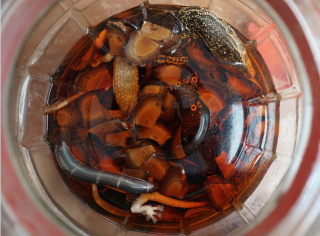
Charles Cong Xu (Ph.D. candidate, Barrett Lab) is working on developing novel genetic methods to detect and monitor illegal production and trafficking of wildlife through steeped alcohol.
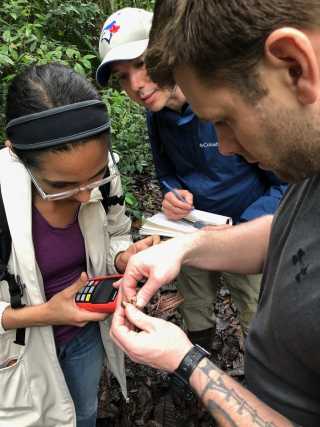
Victoria Marie Glynn (Ph.D. student, Barrett Lab) is measuring an anolis lizard’s rectal temperature during her field course at the Smithsonian Tropical Research Institute, Panama.
Green Lab
Students in the Green Lab work with frog and toad species to understand their ecology, population dynamics, behavior, genetics, and the conservation of their biological diversity.
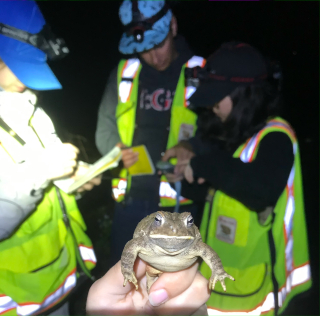
Students and volunteers from the Green Lab are recording information for this locally endangered Fowler’s toad (Anaxyrus fowleri) found at their field site in Long Point, Ontario. The wart pattern on this toad’s back acts like a fingerprint, which has allowed Nathalie Jreidini (Ph.D. student, Green Lab) to assess toad movements over the past three decades.

Nathalie Jreidini (Ph.D. student, Green Lab) and Jessica Ford (Ph.D. student, Green Lab) are adding toad eggs to one of the tanks involved in Jessica’s project, where she studies the ecological consequences of tadpole loss. When these eggs hatch into tadpoles and eventually become toadlets, the toadlets will be released to boost the local population.
Hendry Lab
Students in the Hendry Lab are studying how ecology and evolution interact to shape biodiversity. Their research encompasses Trinidadian guppies, threespine sticklebacks, Darwin’s finches and the Tribulus seeds they feed on, howler monkeys, bluegills and bottlenose dolphins.
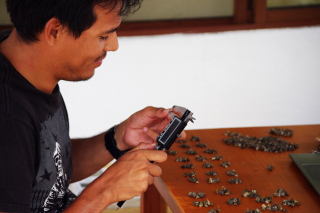
Daniel Reyes (Ph.D. candidate, Hendry Lab), is characterizing the shape and size of the plant Tribulus cistoides’ mericarps (seed-bearing organs). He is exploring how this plant’s traits are evolving in response to predation by Darwin’s finches on the Galápagos Islands in Ecuador.
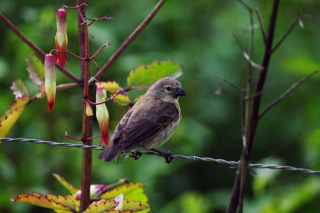
One of the Hendry Lab’s main axes of research surrounds the eco-evolutionary dynamics of Darwin’s finches, pictured here. While working on the Galápagos Islands in Ecuador, students ask questions surrounding how differences in beak size may be driving speciation, and how human disturbance may be reversing speciation
Larsson Lab
Students in the Larsson lab focus on how evolution acting over millions of years shapes the diversity of life. Their projects usually fall within one of the lab’s two main axes of research: (1) palaeobiology and (2) the study of embryonic development. This lab is interdisciplinary in nature, with study systems as varied as crocodiles, extinct marine reptiles, arthropods, fossil plants and chicken embryos.
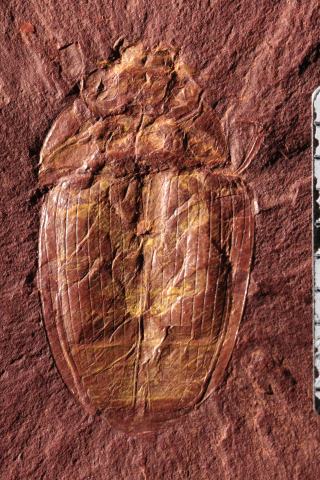
Alexandre Demers-Potvin (M.Sc., Larsson Lab) is searching for plant and insect fossils in an abandoned mine among the boreal forest near Schefferville, Québec, such as the fossilized whirligig beetle fossil shown here. This potentially new species may help complete the picture of its lineage’s evolution.
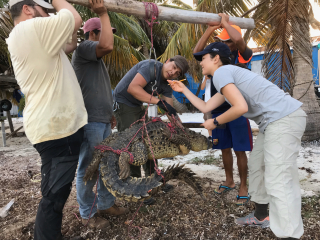
José Avila Cervantes (M.Sc., Ph.D., Larsson Lab) conducts fieldwork in Mexico and Central America, focusing on the evolution and ecology of Neotropical crocodiles.
Millien Lab
Students in the Millien Lab are answering questions surrounding how diversity is evolving with changing environments at different spatial scales, and how community structure of various taxonomic groups is shaped in different ecosystems.
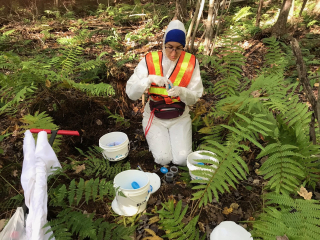
Kirsten Crandall (Ph.D. candidate, Millien Lab) is conducting fieldwork in Ontario and Québec, comparing the patterns of Lyme disease emergence in these two provinces.
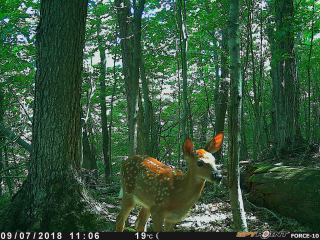
Frédérique Truchon (Master’s candidate, Millien Lab) sets camera traps in the Gault Nature Reserve in Mont Saint-Hilaire, Québec, Canada, to capture white-tailed deers’ (Odocoileus virginianus) spatial use in the reserve.

Jihane Benbahtane (Master’s candidate, Millien Lab) studies parrotfish community structure and its impact on coral reefs in Barbados.
Ricciardi Lab
The Ricciardi Lab uses experimental ecology to examine how aquatic food webs are altered by anthropogenic stressors, such as climate change, micro-plastic pollution, and biological invasions. Students conduct their work in the Great Lakes-St. Lawrence River system, as well as on lakes and rivers in the U.K. and South Africa, using freshwater fishes and invertebrates as their study organisms.

The Ricciardi Lab uses crayfishes (Faxonius spp.) as a model organism to assess how invasive species impact native biodiversity under various environmental conditions.
Student research spotlight
Thank you to all the students who have participated, please find our archives below:
![]() Student Spotlight Archive Volume 4, Issue 3 (Last)
Student Spotlight Archive Volume 4, Issue 3 (Last)
![]() Student Spotlight archives, Volume 3 Issue 3
Student Spotlight archives, Volume 3 Issue 3